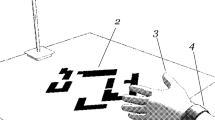Abstract
An important characteristic of virtual assembly is interaction. Traditional direct manipulation in virtual assembly relies on dynamic collision detection, which is very time-consuming and even impossible in desktop virtual assembly environment. Feature-matching is a critical process in harmonious virtual assembly, and is the premise of assembly constraints sensing. This paper puts forward an active object-based feature-matching perception mechanism and a feature-matching interactive computing process, both of which make the direct manipulation in virtual assembly break away from collision detection. They also help to enhance virtual environment understandabilyt of user intention and promote interaction performance. Experimental results show that this perception mechanism can ensure that users achive real-time direct manipulation in desktop virtual environment.
Similar content being viewed by others
Explore related subjects
Discover the latest articles, news and stories from top researchers in related subjects.References
Zhai Shumin, William Buxtion, Paul Milgram. The partial-occlusion effect: Utilizing semitransparency in 3D human-computer interaction.ACM Trans. Computer-Human Interaction, Sept., 1996, 3(3): 254–284.
Zhiqiang Wang, Jiazhen Hong, Hui Yang. A survey of colision detection problem.Journal of Software (in Chinese), May, 1999, 10(5): 545–551.
Peter J Berkelman, Ralph L Hollis, David Baraff. Interaction with a real-time dynamic environment simulation using a magnetic levitation haptic interface device. InProc. the 1999 IEEE International Conference on Robotics & Automation, Detroit, Michigan, May, 1999, pp.3261–3266.
Ram Anantha, Glenn A Krame, Richard H Crawford. Assembly modeling by geometric constraint satisfaction.Computer-Aided Design, 1996, 28(9): 707–722.
Zhaoqi Wang, Qinping Zhao, Chengwei Wang. An object-oriented collision detection method and its application to distributed virtual environment.Chinese J. Computers, November, 1998, 21(11): 990–994.
Jun Qian. A study on component construction model and interactive computation semantics for object systems [dissertation]. Institute of Software, Chinese Academy of Sciences, Beijing, January, 2000.
Tang Chih-sung. Temporal Logic Programming and Software Engineering, 1999, Beijing: Science Press.
Wei Wang, Wenping Wang, Jiaye Wang. An algorithm for finding the smallest circle containing all points in a given point set.Journal of Software (in Chinese), 2000, 11(9): 1237–1240.
Author information
Authors and Affiliations
Corresponding author
Additional information
This work is supported by the National High Technology Development 863 Program of China under Grant No.8630-511-942-012 and the National Natural Science Foundation of China under Grant No. 60033020
CHENG Cheng received his M.S. degree in computer science from Shandong University. Now he is a Ph.D. candidate in Institute of Software, Chines Academy of Sciences. His research interests are CAD and virtual environment human-computer interaction.
WANG HongAn is a researcher in Institute of Software, Chinese Academy of Sciences. He received his Ph.D. degree from Institute of Software, Chinese Academy of Sciences in 1999. His research interests include human-computer interaction and real-time system.
DAI GuoZhong is a chief resercher in Human Computer Interaction & Intelligent Information Processing Lab, Institute of Software, Chinese Academy of Sciences and superviser of Ph.D. candidates. His research interests include human computer interaction, computer graphics and computer-aided design.
Rights and permissions
About this article
Cite this article
Cheng, C., Wang, H. & Dai, G. Construction of feature-matching perception in virtual assembly. J. Comput. Sci. & Technol. 18, 163–171 (2003). https://doi.org/10.1007/BF02948881
Received:
Revised:
Issue Date:
DOI: https://doi.org/10.1007/BF02948881




